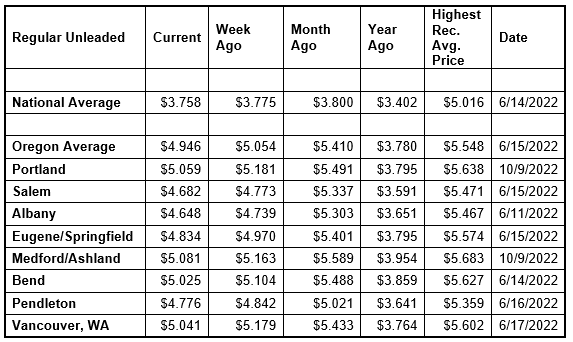
Gas prices continue to fall as expected this time of year with Oregon and other West Coast states again seeing the largest declines in the nation. Tepid demand for gas and crude oil prices below $90 per barrel are the main drivers. For the week, the national average for regular slips two cents to $3.76 a gallon. The Oregon average loses 11 cents to $4.95. This is the third-largest weekly drop for a state in the nation, only behind Alaska (-21 cents) and California (-17 cents).

“Gas prices have been falling for the last three weeks. Here on the West Coast, pump prices shot up in late September after several regional refineries underwent planned and unplanned maintenance, putting a significant crimp in supplies,” says Marie Dodds, public affairs director for AAA Oregon/Idaho. “Barring unforeseen events, lackluster demand for gas in the U.S. along with relatively low crude oil prices should continue to put downward pressure on pump prices.”
The Oregon average came within a penny of reaching a new record high last month when it got to $5.54 a gallon on October 9. The national average climbed to $3.92 on October 11. Both the national and Oregon averages hit record highs in mid-June, then declined for 14 consecutive weeks before rising again starting in late September. The national average reached its record high of $5.016 on June 14 while the Oregon average reached its record high of $5.548 on June 15.
Crude oil prices have stayed below $90 per barrel since October 10. Crude reached a recent high of $122.11 per barrel on June 8, and ranged from about $94 to $110 per barrel in July. In August, crude prices ranged between about $86 and $97. In September, crude prices ranged between about $76 and $88 per barrel. In October, crude ranged between $82 and $92 per barrel.
Crude prices rose dramatically leading up to and in the first few months of Russia’s invasion of Ukraine. Russia is one of the world’s top oil producers and its involvement in a war causes market volatility, and sanctions imposed on Russia by the U.S. and other western nations resulted in tighter global oil supplies. Oil supplies were already tight around the world as demand for oil increased as pandemic restrictions eased. A year ago, crude was around $72 per barrel compared to $88 today.
Crude oil is the main ingredient in gasoline and diesel, so pump prices are impacted by crude prices on the global markets. On average, about 53% of what we pay for in a gallon of gasoline is for the price of crude oil, 12% is refining, 21% distribution and marketing, and 15% are taxes, according to the U.S. Energy Information Administration.
Demand for gasoline in the U.S. increased slightly from 8.68 million b/d to 8.93 million b/d for the week ending October 21. This is nearly 400,000 bbl lower than this time last year. Total domestic gasoline stocks decreased from 209.4 million bbl to 207.9 million bbl. If demand remains low and oil prices don’t spike, pump prices will likely keep falling.
Quick stats
Oregon is one of 34 states and the District of Columbia with lower prices week-over-week. West Coast states have the largest weekly drops: Alaska (-21 cents), California (-17 cents), Oregon (-11), and Washington (-9 cents). Rhode Island (+27 cents) has the largest weekly gain.
California ($5.54) has the most expensive gas in the country for the eighth week in a row. California and Hawaii ($5.21) are the only two states with averages at or above $5 a gallon. This week 11 states, including Oregon, have averages at or above $4, and 39 states and the District of Columbia have averages in the $3-range.
The cheapest gas in the nation is in Georgia ($3.15) and Texas ($3.17). For the 95th week in a row, no state has an average below $2 a gallon.
The difference between the most expensive and least expensive states is $2.39 which is significant.
Oregon is one of 27 states and the District of Columbia with lower prices now than a month ago. The national average is four cents less and the Oregon average is 46 cents less than a month ago. Oregon has the third-largest monthly decrease in the nation. California (-82 cents) and Nevada (-51 cents) have the largest monthly declines. Rhode Island (+46 cents) has the largest month-over-month jump.
Oregon is one of 48 states and the District of Columbia with higher prices now than a year ago. The national average is 36 cents more and the Oregon average is $1.17 more than a year ago. This is the largest year-over-year increase in the nation, followed by Alaska (+$1.12), Washington (+$1.03), Nevada (+$1.03), California (+94 cents), Hawaii (+90 cents) and Arizona (+77 cents)—all of the states in the West Coast region. Colorado (+2 cents) has the smallest year-over-year increase. Georgia (-10 cents) and Florida (-2 cents) are the only two states with year-over-year declines.















